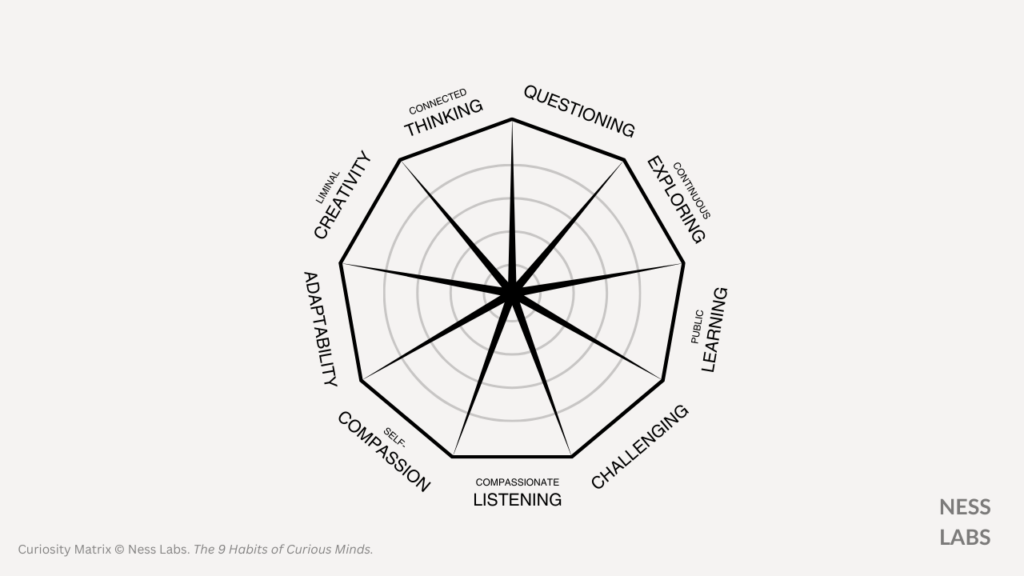All healthy human babies and young children display curiosity, suggesting this is an innate human trait. Exploring our environment and babbling questions appear almost universal in early childhood across cultures.
As an adaptive trait, curiosity draws us to seek information and new experiences. It’s how we learn about ourselves, others, and the world.
However, research shows our degree and focus of curiosity can even vary a lot. Curiosity differs between people, it evolves within one same person over the course of their lifespan, and it can even fluctuate throughout the day.
Some people tend to be more systematically curious than others. Those curious minds are generally adventurous, creative, less risk-averse, and seem to seek and enjoy exploration more than others.
They’re a diverse group of people, but the literature suggests that they share some common habits that support their personal and professional growth.

1. Seeking liminal spaces. Curious minds are not only comfortable in the in-betweens, they actively seek out those transitional moments of personal growth. Rather than racing through the uncomfortable phase of not-knowing, they enjoy exploring the gap between what they know and what they don’t know. They can fall in love with problems and revel in what poet Mary Oliver calls “the pleasure of mystery.”
2. Forming connections between ideas. Instead of thinking about the world in a linear way, curious minds think in maps. They practice networked thinking and combinational creativity, and find delight when discovering an unexpected connection between two ideas. Their mind is a garden and the world a giant playground where ideas can seed their imagination.
3. Asking generative questions. For curious minds, every interaction is an opportunity to learn. Exchanging generative questions is one of their favorite modes of communication. They not only ask about facts, but also about feelings, underlying motivations, and cultural context. Their questions are open-ended, multidimensional, and empathetic. Some of them even keep a list of their favorite questions.
4. Exploring new interests. Because the world is full of potential curiosity attractors, curious minds have many interests which may not always overlap. However, it can be hard to channel their curiosity, and the fleeting urge to explore something new just for the sake of novelty can sometimes lead to distraction.
5. Learning in public. Although it can be scary, curious minds make it a point to admit when they don’t know. Instead of trying to be the expert in the room, they consider themselves lifelong learners. They are willing to be wrong. And they generously share what they learned with fellow curious minds.
6. Challenging the default. Anything that seems obvious on the surface can become a topic of investigation for curious minds. They wonder about the reality of default definitions and test their assumptions through experimentation.
7. Listening with compassion. Because they want to deeply understand the world and others around them, curious minds tend to be empathetic. They try to listen without judgment and to embody the words of Thích Nhất Hạnh: “If we cannot listen mindfully, we cannot practice right speech. No matter what we say, it will not be mindful, because we’ll be speaking only our own ideas and not in response to the other person.”
8. Approaching difficult experiences with self-compassion. Any thought or emotion can be the seed of self-discovery for curious minds. Even without knowing the scientific terms for these habits, they practice metacognition to interrogate the thoughts that arise in their mind and interoception to understand the sensations that arise in their body. They do not try to suppress these signals, but treat them as a helpful source of information.
9. Welcoming the unpredictable. For curious minds, the fact that the world keeps on changing is a feature, not a bug. They believe that their response determines how much disruptions affect them, and they choose to respond with curiosity. They surf with chaos to not only survive, but to thrive in chaotic times.
Curiosity has many benefits – it keeps you young, it helps you learn, and it foster better relationships. Injecting a little bit of curiosity into your life goes a long way.
The good news is, anyone can (re)learn to be more systematically curious in all areas of their lives. Although some studies indicate that curiosity may have a genetic component (DRD4-7R has been dubbed the “wanderlust gene”), most researchers agree that curiosity can be nurtured.
A first step is to go through the nine habits in the Curiosity Matrix and ask yourself: how habitual are these practices in my daily life? What is one habit I can start building today to nurture my curiosity?
